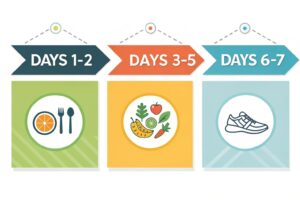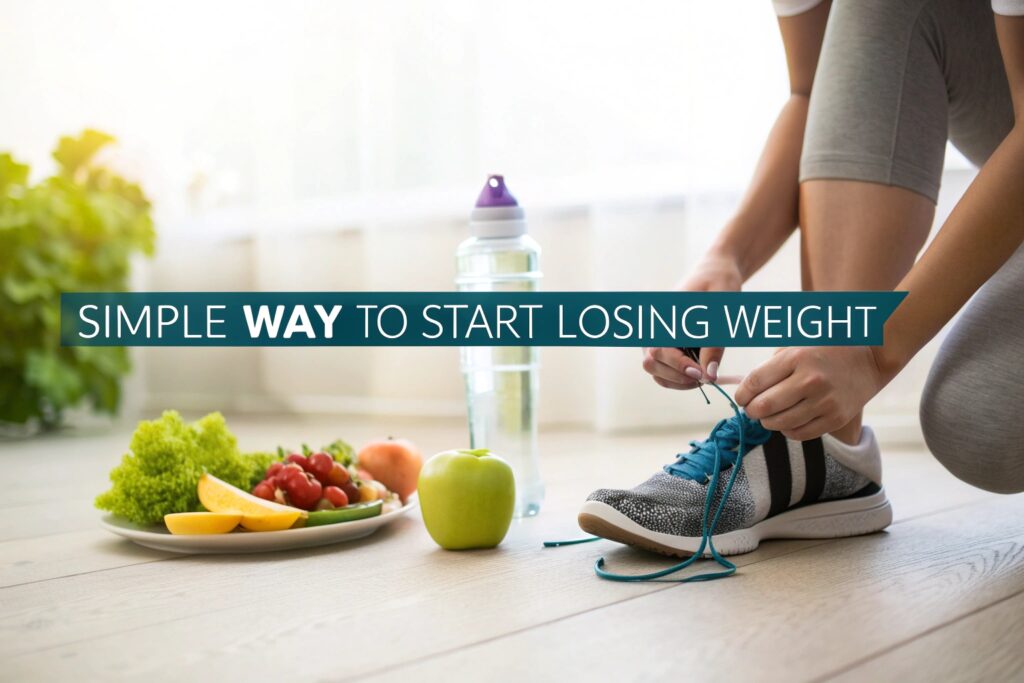Introduction
Stop Overthinking It: The Simple Way to Start Losing Weight-Are you paralyzed by the sheer volume of weight loss advice? Keto, intermittent fasting, HIIT, macros, calorie cycling—it’s enough to make anyone’s head spin. You research endlessly, plan the “perfect” start date, but never actually begin. This cycle of analysis paralysis is the biggest roadblock to success. The truth is, sustainable weight loss isn’t about complexity; it’s about consistency in simple, fundamental habits. This article will cut through the noise and show you the uncomplicated path forward. It’s time to stop overthinking it: the simple way to start losing weight is right here.
Why We Overcomplicate Weight Loss (And Why It Backfires)
Our brains, with a desire to solve complex problems, often mistake weight loss for a complicated equation needing a perfect solution. We get bombarded with marketing for quick fixes and “revolutionary” programs, convincing us that unless we follow a strict, all-or-nothing plan, we’re doomed to fail. This mindset creates a fear of doing it wrong, leading to procrastination. Furthermore, the pursuit of perfection sets an unrealistic standard. The moment we slip up—because we are human and we will—we view it as a total failure and abandon the effort entirely. This perfectionist trap is a primary reason why so many people yo-yo diet instead of making steady, lasting progress.
Consider the common example of someone deciding to “get healthy.” They might spend weeks researching the best diet, buying new containers, downloading five different fitness apps, and planning a start date for next Monday. This initial burst of energy is exciting but unsustainable. The complexity of the new regime becomes overwhelming, and the mental energy required to maintain it is exhausting. By contrast, the most successful long-term “losers” (as identified by the National Weight Control Registry) often lose weight using simple, even mundane methods, like eating breakfast every day and walking regularly. The key isn’t a complex algorithm; it’s a few repeatable behaviors executed consistently.
The Foundational Pillar: Mastering the Art of Mindful Eating

Before you change what you eat, you must change how you eat. Mindful eating is the practice of bringing full attention to the experience of eating and drinking, both inside and outside the body. It’s about observing the colors, smells, textures, and flavors of your food, and, most importantly, tuning into your body’s hunger and satiety cues. In our fast-paced world, we often eat distracted—in front of screens, in our cars, or while working. This disconnection leads to overconsumption because we fail to recognize when we are genuinely full.
How to Practice Mindful Eating Today
You don’t need a meditation cushion to start. Begin with one meal a day. Turn off all screens, put your phone away, and simply sit at a table. Before you take your first bite, take three deep breaths. Chew your food slowly, aiming for 20-30 chews per bite. Put your fork down between bites. This forces you to slow your pace, allowing your stomach and brain to communicate. It takes about 20 minutes for your brain to register that you’re full. By eating slowly, you give this biological process time to work, naturally preventing overeating. Ask yourself throughout the meal: “Am I still hungry? Does this still taste good?” This simple shift from autopilot to awareness is a powerful tool for managing portion control without any calorie counting.
The Simplest Nutritional Shift: Prioritize Protein and Plants
You don’t need to ban entire food groups or obsess over carbs versus fats. The simplest and most effective nutritional change you can make is to structure every meal around a protein source and a plant. This isn’t a rigid “diet”; it’s a flexible framework. Protein (from sources like chicken, fish, eggs, Greek yogurt, lentils, and tofu) is incredibly satiating. It keeps you feeling full and satisfied for longer, reducing the urge to snack mindlessly later. Plants (vegetables and fruits) are packed with fiber, vitamins, and minerals while being low in calories, allowing you to eat a larger volume of food for fewer calories.
For example, instead of overthinking a complicated lunch, apply this framework. Instead of a large bowl of pasta with a little chicken (carb-heavy, less satiating), flip the ratio. Make a large salad with leafy greens, cucumbers, peppers, and tomatoes (the plants), top it with a generous serving of grilled chicken or chickpeas (the protein), and add a sensible serving of a healthy fat like avocado or a light vinaigrette. This meal will keep you energized and full for hours. A study published in the American Journal of Clinical Nutrition has repeatedly shown that higher-protein diets are associated with greater satiety and better adherence to calorie goals. This approach is sustainable because it’s not restrictive; it’s additive and focuses on what you can and should eat more of.
Movement Made Easy: Embrace Non-Exercise Activity Thermogenesis (NEAT)
Many people believe that unless they’re killing themselves in the gym for an hour, it doesn’t count. This is a major misconception. While dedicated exercise is fantastic for health, the calories burned during a 30-minute workout are often a small fraction of your total daily energy expenditure. The secret weapon for many is NEAT—the calories you burn through everything that is not sleeping, eating, or sports-like exercise. This includes walking to your car, gardening, typing, cooking, and even fidgeting. For sedentary individuals, NEAT can account for only 15% of daily calorie burn, while for highly active individuals, it can be as high as 50%.
Increasing Your NEAT is the Hassle-Free Fitness Strategy
The beauty of focusing on NEAT is that it requires no special equipment, clothing, or time. It’s about seamlessly weaving more movement into your existing routine. Actionable steps include: taking a 5-10 minute walk after every meal (a double win for blood sugar regulation and NEAT), using a standing desk or taking standing breaks if you sit all day, pacing while on phone calls, parking farther away in parking lots, taking the stairs, and doing a “walk and talk” meeting instead of a sit-down one. These micro-activities add up significantly over a week. A 2018 review in the Journal of Exercise Nutrition & Biochemistry highlighted that increasing NEAT can be a crucial component in weight management and overcoming metabolic adaptation. It’s the simple, overlooked way to move more without ever setting foot in a gym.
Your Action Plan: The “Stop Overthinking” Step-by-Step Guide

Let’s translate these concepts into a clear, actionable one-week plan. The goal is not perfection, but practice. Pick one or two of these to focus on each day.
Days 1-2: Implement Mindful Eating. Choose one meal per day to eat without distractions. Use the techniques above to slow down and listen to your body. Don’t change your food yet; just change your eating behavior. Notice how different you feel during and after the meal.
Days 3-5: Apply the Protein + Plants Framework. For each meal, ask yourself: “Where is my protein? Where are my plants?” Build your plate starting with these two elements. Ensure half your plate is vegetables, a quarter is protein, and the remaining quarter can be a complex carb like quinoa or sweet potato if desired.
Days 6-7: Boost Your NEAT. Set a simple goal: walk for 10 minutes after one meal each day. Use a pedometer or your phone to track your steps. Aim to add 2,000-3,000 steps to your daily average from the previous week. See how easy it is to find opportunities to move.
Track how you feel—your energy levels, your hunger, your mood. This data is more valuable than any number on a scale this early on. These small wins build confidence and prove that change doesn’t have to be hard.
Sustaining Momentum: Overcoming Plateaus and Cultivating Patience
Weight loss is not linear. Everyone encounters plateaus, and they are the moment where most people overthink, panic, and quit. Understand that a plateau is a normal part of the process. Your body is adapting. Instead of resorting to a drastic new diet, first double down on the basics: are you still practicing mindful eating? Have your portions slowly crept up? Has your NEAT decreased because you’ve been busy? Often, a simple recalibration is all that’s needed.
Compare this simple approach to the complex diet roller coaster. The complex path is fueled by restriction, leads to constant hunger, and is mentally exhausting. It often results in rapid weight loss followed by rapid regain. The simple path, focused on habits, is sustainable. It’s slower, but the weight stays off because you’re not “on a diet”; you’re upgrading your lifestyle. The biggest challenge is mental: trusting that these small, simple actions will compound into significant results over time. It requires patience and faith in the process.
In conclusion, the journey to a healthier weight doesn’t start with a perfect plan. It starts with a simple action. Stop waiting for the perfect moment. Stop researching endlessly. Stop overthinking it: the simple way to start losing weight is to begin today with one tiny change. Master the art of eating mindfully, build your meals on a foundation of protein and plants, and find joy in moving your body naturally throughout the day. Trust the process, be patient with yourself, and watch how these small steps lead to a giant leap in your health and well-being.
What’s the one simple change you’ll commit to starting today? Share your goal in the comments below to hold yourself accountable! For more practical tips on sustainable health, explore our guide on [Building Healthy Habits That Actually Stick].



